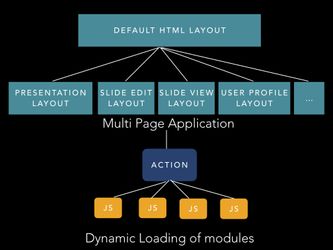Splitting layout
- multi-page application → in components/defaultHTMLlayout.js → based on URL load certain libraries (e.g. CKeditor for visiting URL /edit)
- we can have a generic layout inherited by other layout if needed (e.g. ui intl libraries or shim libs need to be reused in most of the other layouts).
- multiple single-page applications → standalone aplication. E.g. presentation layout (reveal.js is large), slide edit layout (CKeditor = 600kb, Latex_ams.. libary = 500kb, ), slide view, user profile layout, etc... In practice → separate github repot + is separate application → has own server.js/client.js/etc...
- multiple single-page applications → Better for scalability
- multi-page application → better for user loading (only load libraries when necessary, based on URL/page visit)
- Presentation mode - standalone/multiple single-page applications - do not need to load fluxible, etc.. (single page application). Needs to load reveal.js and Latex_ams.. libary and maybe some SVG/diagram libraries, semantic UI)
- exam mode (
- user profile
- slide edit layout → multipage → part of platform → on loading /edit also load ckeditor, Latex_ams.. libary and some SVG/diagram libraries
Based on presentation (general-optimization.pdf) on optimization by Ali Khalili during Hackathon V3.0
Dynamic/lazy loading of modules
→ action → select j.s. file . use ES6 require.ensure - Darya Tarasowa - interesting in applying - related to multi-language UI.
- Is complicated
- Is good for when other developers want to work on something → we give bundle with component, action, js. files/libraries
Optimise Current libraries
(see webpack visualiser: https://platform.experimental.slidewiki.org/public/js/stats.html) → check npm packages
- replace with another library (e.g. lodash is using 20% of our vendor.bundle.js code, maybe it can be replaced by a simpler one), or
- use own functions
Server Side Rendering (SSR) Insights
Description of the flow
The page is initially always rendered server-side. This means:
- a react + flux session is initiated and executed
- all needed actions are executed (waiting for responses, adding results to stores, rerendering, ...)
- if everything is ready and nothing is pending anymore, the page gets serialised to a valid html document, that is delivered to the browser
- listed libs in the DefaultHTMLTemplate are downloaded at the browser (not as of the SSR process)
For https://slidewiki.org/deck/82 , this takes about 25.86s and the file is about 5MB large (compressed to 700KB by gzip)
What's included to the file:
- Site structure (needed)
- store states (containing ALL slides/decks --> that's a large part of the document)
- rendered HTML contains some data that is also in the store (like users, slides, decks, ...) --> duplicated data in the response
- users are included several times in different stores (each time with their base64 user picture, that is a large part of the user) --> duplicated data in the response
- presentationStore and deckViewStore contain all slides of a deck + extra data --> duplicated data in the response - think of soerens deck, that has 800 slides --> these are included at least twice!
Possible improvements
Main Showstoppers:
- waiting for upstream (service) requests
- componentUpdate events might occur very often and trigger (possibly unneeded) rerenderings of the component
- there is no server-side cache for upstream requests to services - data will be requested again and again and again as SSR won't keep any states/contexts over time --> adding cache headers to responses from services will have no impact
Options to improve the situation:
- load only a part of the deck/slides instead of ALL of it (this is by far the largest part of the file) - e.g. always load the "next" 10 slides (5 before and 5 after the currently displayed one) and to fetch more if needed + removing old slides from the store/DOM in order to keep it small and responsive
- decreasing the initial deck load by adding/using a minimal deck-service call
- there are already https://deckservice.experimental.slidewiki.org/documentation#!/deck/getDeckId (deck metadata) and https://deckservice.experimental.slidewiki.org/documentation#!/slide/getSlideId (data of first slide)
- locate and replace the initial deckservice-call (currently: load all slides of a deck) with the two above minimal deck-service calls
- try to reuse information that is already contained in other stores, instead of downloading and saving them a second time to a different store
- save user pictures as actual pictures to the file-service instead of base64, so they are handled by the browser instead of included into the SSR response
- execute as many requests as possible in parallel and try to optimise response times (at the services) or request smaller amounts of data at all
- try to only update (rerender) components once, instead of several times - see https://marmelab.com/blog/2017/02/06/react-is-slow-react-is-fast.html
- it's possible to use React component caching (instead of rerendering them for each request), but this non trivial to implement, requires a lib that hot patches react itself on execution time and needs to be specified for each component separately - see https://www.npmjs.com/package/react-ssr-optimization
- try to load data on user events, instead of prefilling stores/DOM (e.g. request data in case the user opens a tab, instead of downloading that data as the user visits the page)
Fetchr Insights
- cache responses from fetcher (slidewiki-platform --> browser) by using cache directives. This will not improve SSR timings, but may improve requests from the browser to slidewiki-platform. See https://github.com/yahoo/fetchr#service-metadata . I think this is only useful if we also do:
- restrict context variables to have smaller/more simple requests that are better cachible, see https://github.com/yahoo/fetchr#service-metadata
- there is no server-side cache for upstream requests to services - data will be requested again and again and again as SSR won't keep any states/contexts over time --> adding cache headers to responses from services will have no impact
- Requesting a service directly takes only a little amount of time (e.g. forking a deck: 300ms). Doing the same thing through slidewiki-platform with the full fetchr, encryption, compression and transformation workflow takes significantly more time (about 6-9 secs)
- slidewiki-platform server side is a bottleneck to all service → we don't know if this is responsible for the time increase
- slidewki-platform is doing some transformations at some services
- the full cycle via slidewiki-platform inclused a lot more ecnryption/decryptiond and compression/decompression steps
- → We need to somehow measure timings of routes and CPU load of services/containers (use cadvisor + store data, use NewRelic)
--> this needs to be implemented for each slidewiki-platform service and method (if it's useful!)
Further insights from looking into slidewiki-platform:
- in case I change from one slide to another one, the whole deck is requested and downloaded again in order to display one slide (via service presentation.js, read method)
- only one slide should be requested instead of all + this data is currently available in a store (why requesting it another time?
- all libs in defaultHTMLLayout.js are loaded in order - try to use "async" or "defer" to load libs (if this is possible!)


